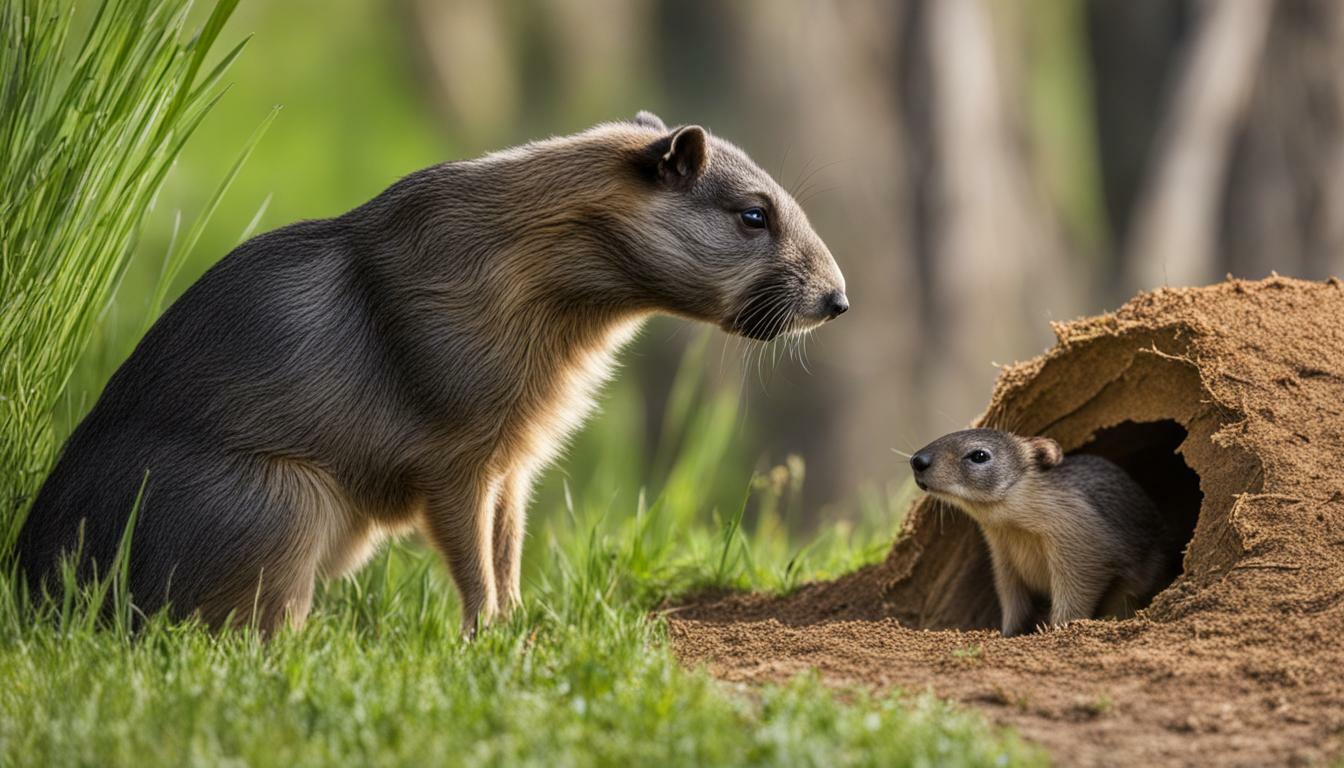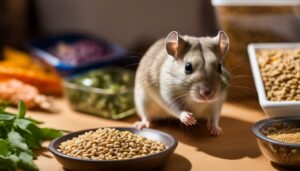Groundhogs are typically non-confrontational creatures, but it is important to understand the potential dangers they may pose to dogs. While they generally prefer to avoid interactions with other animals, groundhogs may resort to aggression if they feel threatened or cornered. This article aims to provide insights into groundhog behavior around dogs, the risks involved in dog-groundhog encounters, and practical measures to protect your furry friends.
Key Takeaways:
- Groundhogs may attack dogs if they feel threatened or cornered.
- Small breed dogs may be more evenly matched with groundhogs, while larger breed dogs have the advantage.
- Groundhogs have sharp teeth and claws that can cause injuries to dogs.
- If a dog is bitten by a groundhog, immediate veterinary attention is necessary to check for potential rabies transmission.
- It is important to monitor and supervise dogs around groundhogs to prevent physical confrontations.
Understanding Groundhog Behavior Around Dogs
Before delving into the potential risks, it is crucial to have a basic understanding of how groundhogs behave around dogs. Groundhogs are generally non-confrontational creatures, and they will typically only attack a dog if they feel threatened or cornered.
It is important to note that smaller breed dogs may be more evenly matched with a groundhog, while larger breed dogs have the advantage in size and strength. Groundhogs possess sharp teeth and claws that can cause injuries to a dog if an encounter turns aggressive.
While dogs may be naturally curious and inclined to chase groundhogs, it is essential for owners to closely monitor their pets and prevent them from engaging in physical confrontations with groundhogs. This is particularly important as groundhogs can transmit rabies through bites. If a groundhog bites a dog, immediate veterinary attention is necessary to address any potential health risks.
In addition to rabies, there are other risks associated with groundhog encounters. Groundhogs can carry ticks, fleas, and roundworms, which can be transmitted to dogs during an interaction. Regular preventive measures such as flea and tick treatments and routine veterinary check-ups are vital to keeping dogs safe.
| Groundhog Behavior Around Dogs | Groundhog Safety with Dogs |
|---|---|
| Non-confrontational | Monitor and prevent physical confrontations |
| Bites when threatened or cornered | Seek immediate veterinary attention if bitten |
| Size can influence encounters | Protect smaller breed dogs from potential harm |
| Potential transmission of rabies | Regular veterinary check-ups and preventive measures |
| Carry ticks, fleas, and roundworms | Implement regular flea and tick treatments |
Overall, it is important for dog owners to take precautionary measures to ensure the safety of their pets during potential encounters with groundhogs. By closely monitoring their dogs, preventing physical confrontations, seeking immediate veterinary attention if necessary, and implementing preventive measures, owners can minimize the risks associated with groundhog interactions and provide a safe environment for their beloved furry companions.
Size Matters: Groundhog Encounters with Different Dog Breeds
When it comes to groundhog encounters, the size of your dog can make a difference in the level of risk involved. Groundhogs are generally non-confrontational animals, but if they feel threatened or cornered, they may resort to aggression as a means of defense. This is particularly important to consider if you have a small breed dog, as they may be more evenly matched with a groundhog in terms of size and strength.
It’s important to note that larger breed dogs tend to have the advantage in these encounters, thanks to their size and strength. However, even a larger dog can still sustain injuries from a groundhog’s sharp teeth and claws. If a groundhog bites your dog, there is also the risk of transmitting rabies, which underscores the importance of seeking immediate veterinary attention in such cases.
Dogs are naturally curious creatures and may be inclined to chase after groundhogs. As a responsible dog owner, it’s crucial to monitor your dog’s behavior and prevent them from physically confronting groundhogs. Physical altercations can lead to injuries for both the dog and the groundhog, so it’s best to avoid such situations altogether.
In addition to the risk of injury, groundhog encounters also come with other potential risks. Groundhogs can carry ticks, fleas, and roundworms, which can be transmitted to your dog during an encounter. To protect your furry friend, it’s essential to regularly administer preventive measures such as tick and flea treatments, as well as regular deworming.
| Breed Size | Level of Risk in Groundhog Encounters |
|---|---|
| Small Breed | Higher risk due to size similarity with groundhogs |
| Medium Breed | Moderate risk depending on individual dog’s behavior |
| Large Breed | Lower risk due to size advantage over groundhogs |
Protecting Your Dog from Groundhog Encounters
- Keep your dog on a leash when in areas known to have groundhog activity.
- Securely fence your property to prevent groundhogs from entering.
- Limit your dog’s access to potential groundhog habitats, such as gardens or wooded areas.
- Train your dog to respond to commands, enabling you to control their behavior around groundhogs.
- Regularly check your dog for ticks or signs of flea infestation.
By taking these precautions and being vigilant, you can minimize the risk of encounters between your dog and groundhogs. Remember, the safety and well-being of your beloved pet should always be a top priority!
The Potential for Groundhog Aggression
While groundhogs are generally non-confrontational, they can become aggressive if they perceive a threat. This aggression is typically a defense mechanism to protect themselves from predators, including dogs. When a groundhog feels cornered or threatened, it may display aggressive behavior, such as hissing, growling, or even biting.
It’s important for dog owners to be aware of the potential for groundhog aggression and take necessary precautions to keep their pets safe. Small breed dogs may be more evenly matched with a groundhog, while larger breed dogs have the advantage due to their size and strength. However, even larger dogs can be at risk of injury from a groundhog’s sharp teeth and claws.
If a groundhog bites a dog, there is also the risk of rabies transmission. Rabies is a serious viral disease that can be fatal if left untreated. Therefore, it is crucial to seek immediate veterinary attention if a dog is bitten by a groundhog. Vaccinating your dog against rabies is also important in preventing the spread of the disease.
Dogs may naturally be curious and inclined to chase groundhogs, but it is the responsibility of the owner to monitor their dog and prevent physical confrontations. This can be achieved through leash training, creating physical barriers such as fences, and supervising outdoor activities. It’s crucial to remember that groundhogs are wild animals and should be treated with caution to avoid potential harm to both dogs and humans.
| Key Points: |
|---|
| Groundhogs can become aggressive when they feel threatened or cornered. |
| Small breed dogs may be more vulnerable to groundhog aggression compared to larger breed dogs. |
| Groundhogs have sharp teeth and claws that can cause injuries to dogs. |
| Immediate veterinary attention is necessary if a groundhog bites a dog to prevent the risk of rabies transmission. |
| Owners should monitor their dogs and take precautions to prevent physical confrontations with groundhogs. |
| Groundhogs are wild animals and should be treated with caution to avoid potential harm. |
The Risk of Groundhog Bites and Transmission of Rabies
Groundhog bites can pose a risk to dogs, not only due to the physical injuries they can cause but also because of the potential transmission of diseases like rabies. Groundhogs have sharp teeth and claws that can cause painful wounds and serious injuries to dogs. However, it is important to note that groundhogs are generally non-confrontational and will only resort to aggression if they feel threatened or cornered.
If a dog is bitten by a groundhog, immediate veterinary attention is necessary. This is because groundhogs are known carriers of rabies, a viral disease that can be transmitted to dogs through bites. Rabies is a serious and potentially fatal condition that affects the central nervous system. It is crucial to monitor the dog for any signs of rabies, such as changes in behavior, aggression, excessive drooling, or difficulty swallowing.
To minimize the risk of groundhog bites and the potential transmission of rabies, it is important for dog owners to be proactive in preventing dog-groundhog confrontations. This includes keeping dogs on a leash when in areas where groundhogs are present, avoiding areas where groundhog burrows are located, and providing proper supervision when dogs are outside. Additionally, ensuring that dogs are up to date on their rabies vaccinations is vital in protecting them from the disease.
| Potential Risks: | Preventive Measures: |
|---|---|
| 1. Groundhog bites | – Keep dogs on a leash – Avoid areas with groundhog burrows – Provide supervision when outside |
| 2. Transmission of rabies | – Immediate veterinary attention – Keep dogs up to date on rabies vaccinations |
| 3. Other risks (ticks, fleas, roundworms) | – Conduct regular preventive measures for dogs – Maintain cleanliness and hygiene in the surrounding areas |
Preventing Dog-Groundhog Confrontations
Taking proactive steps to prevent dog-groundhog confrontations is key to ensuring the safety of your furry friend. Groundhogs are generally non-confrontational creatures, but they may feel threatened when approached by dogs, leading to potential aggression. To protect your dog from groundhog encounters, consider implementing the following measures:
- Secure your property: Install a sturdy fence around your yard to prevent groundhogs from entering. Ensure that the fence is buried at least one foot deep to deter them from burrowing underneath. Regularly inspect the fence for any damages or holes that could allow groundhogs to sneak in.
- Eliminate enticing attractions: Keep your yard free from food sources that may attract groundhogs, such as fallen fruits, nuts, or exposed garbage. Clear away vegetation, especially near fences, as groundhogs are skilled climbers.
- Supervise outdoor activities: When your dog is outside, be sure to keep a watchful eye on them. If you notice your dog showing interest in a groundhog, redirect their attention with a firm command or a favorite toy. Remember, curiosity can lead to chasing, which could result in a dangerous encounter.
Additional tips for protecting your dog:
- Consider using groundhog deterrents: Explore the use of natural repellents, such as garlic or castor oil, to discourage groundhogs from venturing near your property.
- Consult a professional: If groundhogs continue to pose a threat to your dog’s safety despite your efforts, seek assistance from a pest control expert who can employ safe and effective methods for managing groundhog populations.
By following these preventive measures, you can minimize the risk of dog-groundhog confrontations and create a safer environment for your beloved canine companion. Remember to always prioritize the well-being of your dog and take the necessary precautions to keep them protected from potential dangers.
| Prevention Strategies | Effectiveness |
|---|---|
| Installing a secure fence | Highly effective |
| Removing enticing attractions | Effective |
| Supervising outdoor activities | Essential |
| Using natural repellents | Varies in effectiveness |
| Consulting a pest control expert | Dependent on the situation |
Other Risks Associated with Groundhog Encounters
Apart from the potential for aggression and bites, there are other risks that dog owners should be aware of when it comes to groundhog encounters. These furry critters can also pose a threat in terms of transmitting parasites and diseases to dogs. Ticks, fleas, and roundworms are among the common pests that groundhogs may carry, and these can be easily passed onto your beloved pet.
Table 1 provides a summary of the common risks associated with groundhog encounters:
| Risks | Description |
|---|---|
| Tick Infestation | Groundhogs often harbor ticks, which can latch onto dogs and transmit diseases such as Lyme disease and Rocky Mountain spotted fever. |
| Flea Infestation | These pests can easily jump from groundhogs to dogs, causing discomfort and potential health issues. |
| Roundworm Transmission | Groundhogs can be carriers of roundworm eggs, and dogs can become infected if they come into contact with contaminated soil or feces. |
It’s essential to keep your dog protected by regularly checking for and removing ticks, using flea prevention products, and administering regular deworming treatments as recommended by your veterinarian. Additionally, maintaining a clean and hygienic yard can help reduce the risk of encountering these parasites.
If you notice any signs of infestation or suspect that your dog may have been exposed to ticks, fleas, or roundworms, consult your veterinarian for appropriate treatment options. Remember, prevention is key in ensuring the wellbeing of your furry companion.
Monitoring and Supervising Dogs Around Groundhogs
Being watchful and proactive is crucial when it comes to monitoring your dog around groundhogs. While groundhogs are typically non-confrontational, they may feel threatened if approached or cornered by a dog. To ensure the safety of both your dog and the groundhog, here are some important steps to follow.
1. Keep Your Dog on a Leash
When walking your dog in areas where groundhogs are commonly spotted, make sure to keep your dog on a leash. This will allow you to maintain control and prevent any unexpected encounters. By avoiding off-leash walks near groundhog burrows or habitats, you can minimize the risk of your dog chasing or getting too close to a groundhog.
2. Create a Secure Outdoor Space
If you have a backyard or outdoor space where groundhogs are present, ensure that it is securely fenced. A sturdy fence that extends below ground level will discourage groundhogs from entering and prevent them from coming into direct contact with your dog. Regularly inspect the fence for any gaps or damage that could potentially allow groundhogs to enter.
3. Remove Attractants and Deter Groundhogs
Take steps to make your property less appealing to groundhogs. Clear away any food sources, such as fallen fruits or vegetables, and secure garbage cans with tight-fitting lids. Additionally, consider using natural deterrents like strong-smelling plants or commercial repellents to discourage groundhogs from frequenting your yard.
| Monitoring and Supervising Dogs Around Groundhogs |
|---|
| Keep your dog on a leash when walking in areas with groundhogs |
| Create a secure outdoor space with a fenced yard |
| Remove attractants and deter groundhogs from your property |
By following these guidelines, you can minimize the risk of dog-groundhog encounters and ensure the safety of your beloved pet. Remember to always consult your veterinarian if your dog has any interactions with groundhogs or if you suspect a groundhog bite. Taking proactive measures will help create a harmonious coexistence between your dog and these furry creatures.
The Importance of Groundhog Prevention Measures
Taking preventive measures to keep groundhogs away is essential to safeguarding your dog from potential encounters. While groundhogs are generally non-confrontational, they may become aggressive if they feel threatened or cornered. This can lead to injuries for both the groundhog and your beloved pet. Implementing effective prevention measures will not only help protect your dog but also ensure the safety and well-being of these burrowing rodents.
One effective way to deter groundhogs from your property is by installing a sturdy fence. A fence that reaches at least three feet below ground level can help prevent groundhogs from burrowing under and accessing your yard. Additionally, consider using materials like chicken wire or hardware cloth to make it difficult for groundhogs to climb or dig through the fence.
Garden maintenance is another crucial aspect of groundhog prevention. Groundhogs are attracted to lush vegetation, so it’s important to keep your lawn well-trimmed and remove any fallen fruits or vegetables. Regularly inspect your property for any potential entry points, such as gaps or holes in your walls or foundations, and seal them off to prevent groundhogs from gaining access.
| Prevention Measures | Benefits |
|---|---|
| Installing a sturdy fence | Protects your yard from groundhog invasion |
| Maintaining a well-trimmed lawn | Reduces groundhog attraction to your property |
| Sealing off potential entry points | Prevents groundhogs from accessing your home |
When supervising your dog outdoors, it’s important to be vigilant and proactive. Keep a close eye on your dog’s behavior and intervene if you notice any signs of aggression or excessive curiosity towards groundhogs. Using a leash can help maintain control and prevent your dog from chasing or approaching groundhogs. It’s also advisable to keep your dog’s vaccinations up to date, as groundhog bites can potentially transmit diseases like rabies.
By implementing these preventive measures and maintaining a watchful eye, you can minimize the risk of your dog encountering groundhogs. This will not only ensure the safety of your beloved pet but also contribute to a harmonious coexistence with these creatures in your surrounding environment.
Conclusion
While groundhogs generally prefer to avoid confrontations, it is important for dog owners to be vigilant and proactive in protecting their furry friends from potential harm. Groundhogs are typically non-confrontational and will only attack a dog if they feel threatened or cornered. However, small breed dogs may be more evenly matched with a groundhog, while larger breed dogs have the advantage in size and strength.
Groundhogs possess sharp teeth and claws that can cause injuries to a dog. If a groundhog bites a dog, there is also a risk of transmitting rabies. Therefore, immediate veterinary attention is necessary to ensure the health and safety of the dog. It is crucial for owners to monitor their dogs closely and prevent them from engaging in physical confrontations with groundhogs.
In addition to potential bites and transmission of rabies, there are other risks associated with groundhog encounters. Groundhogs can carry ticks, fleas, and roundworms, which can be transmitted to dogs during interactions. Regular preventive measures, such as tick and flea control, as well as deworming, are essential to protect dogs from these risks.
Overall, dog owners should take precautionary measures to keep their pets safe from groundhogs. This involves implementing groundhog prevention strategies, such as fence installation and garden maintenance, to deter groundhogs from entering the vicinity of their property. By being proactive and attentive, dog owners can minimize the risks associated with groundhog encounters and ensure the well-being of their beloved canine companions.
FAQ
Are groundhogs dangerous to dogs?
Groundhogs are generally non-confrontational and will only attack a dog if they feel threatened or cornered.
How do groundhogs behave around dogs?
Groundhogs typically exhibit natural instincts and tendencies around dogs. It is important to ensure the safety of both dogs and groundhogs during encounters.
Do groundhogs pose a greater threat to certain dog breeds?
Small breed dogs may be more evenly matched with a groundhog, while larger breed dogs have the advantage.
Can groundhogs become aggressive towards dogs?
There is potential for groundhog aggression towards dogs, especially if they feel threatened. Caution is necessary during dog-groundhog interactions.
Are groundhog bites a concern for dogs?
Groundhogs have sharp teeth and claws that can cause injuries to a dog. If a groundhog bites a dog, it can transmit rabies, so immediate veterinary attention is necessary.
How can I prevent dog-groundhog confrontations?
Dog owners should monitor their dogs and prevent them from physically confronting groundhogs. Implementing preventive measures such as fence installation and garden maintenance can help deter groundhogs.
What other risks are associated with groundhog encounters?
Groundhog encounters can lead to the transmission of ticks, fleas, and roundworms, posing additional risks for dogs. Regular preventive measures should be taken.
How should I supervise dogs around groundhogs?
It is important to be vigilant and proactive when dogs are in proximity to groundhogs. Monitoring and supervision can help prevent any harm to dogs.
Why is it important to take groundhog prevention measures?
Groundhog prevention measures, such as fence installation and garden maintenance, are crucial to protect dogs from potential dangers associated with groundhog encounters.




